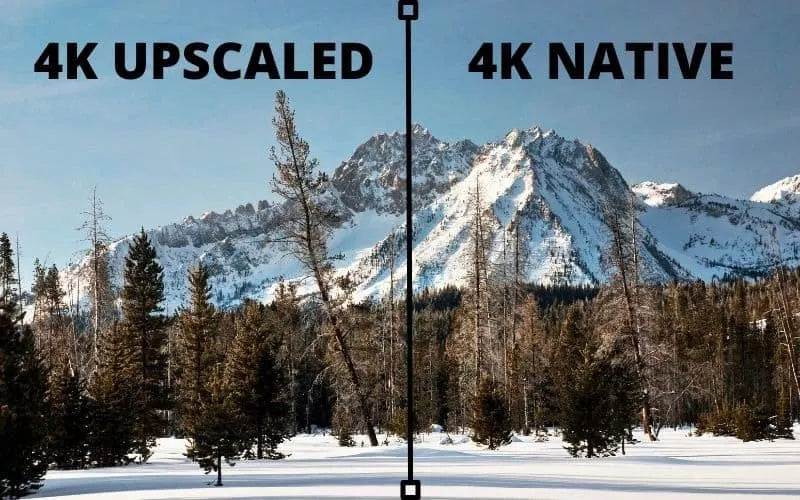There is a plethora of projectors available depending on the use case, budget and preferences, and while researching on the subject you may have already come across the popular, contemporary terms like home cinema 4k projector, native projector or pixel shift 4k home projector theatre.
When it comes to the desired resolution, both native 4K and pixel shifting units hit right, however, they go about it in different ways and it’s best to know which is which before you decide to invest in the critical pieces of kit for your home cinema.
In this explainer guide on 4k projectors, we cover key points on native 4k projectors and the technology of pixel shifting used in 4k UHD resolution projectors.
Also Read: Here's everything you need to know before you buy a home theatre projector
An overview of 4K UHD resolution (Pixel Shifted)
Essentially, 4K UHD resolution is the consumer market standard.
4K UHD TV's panel has a native resolution of 3840 x 2160 pixels. A 4K UHD resolution projectors achieves this resolution by leveraging a technology called "pixel shifting."
Different manufacturers implement this technology differently, but for the uninitiated– it overlays two HD images on top of each other (depending on the projector's panel/chip), shifted by a half a pixel up, down, left or right quickly so the naked eye can’t place the shifting.
The display panel can be native 1080p.
Some DLP models might use a chipset using 2176x1528 micromirrors, the device projects the same pixels twice, creating twice as many pixels on the screen, leading to a crisper image, as an outcome.
The 4K resolution on projectors can be different from the 4K on TVs.
Here the resolution can be 4096 x 2160 or 8.8 million pixels, however, some projectors still use the 3840 x 2160 resolution found on TVs which equals to a tentative 8.3 million pixels.
These are achieved in two different ways by pixel shifting and native 4K projectors respectively.
Pixel shifting - what is it? Let’s take a look at the basics
Pixel shifting is an alternative way of creating a 4K image that uses smart image processing and an HD chipset.
Here, a projector outputs two 1920 x 1080 images, with one shifted slightly to the side; these two images overlap creating a 4K image which (in theory) should look more detailed than a 1920 x 1080 HD image.
The duplication of two 1920 x 1080 images creates the 3840 x 2160 resolution that is aimed for, creating the roughly 8.3 million pixels required for 4K.
Different companies often brand their pixel shifting 4k home theatre projectors differently.
Some use the term “E-Shift”, some call it “4K Enhancement '' and for other brands of the projectors, you may see the term XPR leveraged for their pixel shifting projectors.
Pixel shifting - why should you choose it?
The difference between the two methods of achieving 4K is down to the price of manufacturing; 1920 x 1080 chipsets are more cost-effective than native 4K chipsets, meaning the cost of making these pixel-shifting units remains in check.
It's also common for pixel-shifting units to use DLP or LCD backlighting systems, which is relatively cheaper than laser backlighting units on average.
Also Read: Different Types of Best Projectors for Home Theater in 2023
Native 4K - what is it?

The native 4K projectors use three chipsets that output a 4096 x 2160 image by reproducing each of those 8.8 million pixels separately.
This is done by the chipset without any processing or duplication of pixels; this is why it’s popularised as “True 4K” on some projectors.
Native 4K capabilities and shortcomings

Native 4K projectors can reproduce each of those 8.8 million pixels individually, they often result in an unrivalled, crisp image that pixel-shifting units often can’t recreate.
However, pixel-shifting units DO NOT produce a subpar 4K picture by any means, despite the tough challenge of trying to meet the native 4K’s ability to extract the extra detail from that higher pixel count.
In most cases, native 4K projectors will easily surpass the pixel shifting technology based projectors, so it’s highly recommended to choose the native 4K projectors.
Bear in mind though that upgrading your favourite content to native 4K can result in a dent in your pocket. Besides, anything shot on 2K digital cannot be made native 4K.
Also Read: Debunking home theatre projector myths
Final word on Native 4K Projectors and Pixel Shift 4K Home Theatre Projectors
Conclusively, while a native 4K chipset is definitely the more superior quality option, it can only be considered by those who have no budget bracket and can easily invest some serious money into an elaborate, high-end home theatre setup.
Pixel shifting often gets a bad rap, touted as the “fake 4K” by many, however, it brings a huge upgrade over native 1080p projectors for a much more reasonable price and there are plenty of non-native 4K projectors that offer an enjoyable experience.
There is no reason why you should hesitate in picking one when the budget is predetermined and there is no room for an indulgence.
On the other hand, native 4K is an enriching experience and the right pick for you if the budget is of no constraint.
Hopefully, this blog gave you a quick overview of the key differences between the native 4k projectors and the pixel shift 4K home theatre projectors. You can now reach out to our experts at Ooberpad who can answer your questions in-depth and help you with reliable information.







